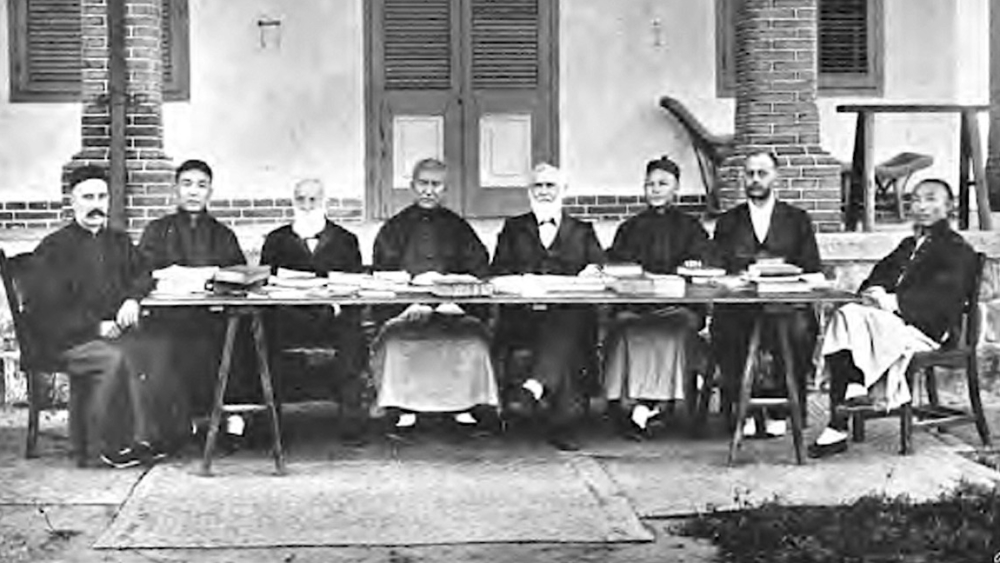China's favourite Bible turns 100
Happy birthday to the book that changed a nation
Published on 22 April 1919 in Shanghai, the Chinese Union Version Bible (CUV) was the largest Bible translation project in the history of the Chinese Protestant Church.
Spanning three decades, it survived major political events such as the Boxer Rebellion, collapse of the Chinese empire and World War I.
The CUV version contributed remarkably to the tremendous growth of the Chinese Church
The translation work involved 16 missionary Bible translators of different nationalities, denominations and mission societies, an even higher number of Chinese translators and assistants, and the crucial support of the Bible Societies.
As for its circulation, hundreds of ‘colporteurs’ (someone employed by a religious society to distribute Bibles and other religious tracts) across China helped sell and distribute the Bibles in cities, as well as far-flung towns and villages.
Enduring the test of time, the CUV remains today the predominant translation used by most Chinese Christians. This is not only in China but also in Chinese-speaking churches the world over.
For the past 100 years, the CUV has been gladly embraced by Chinese-speaking believers from all walks: layman Christians who read, memorise and quote from it, Chinese pastors who preach from it, churches that read it during service, Bible lecturers who teach with it and seminarians who study it during their theological training.
This much beloved translation has accompanied the Chinese Church through the past century, where Chinese believers learn the language of faith and the Chinese Church had her theological vocabulary shaped.
It is also the version that has contributed remarkably to the tremendous growth of the Chinese Church both spiritually and numerically, especially during the past few decades.
How did the CUV become the single dominant version when there were about 27 Bible translations in China at that time?
What role did the Bible Societies play? And what was its initial impact on the Church and society?
Why and How the CUV Came About
By the second half of the 19th century, there were different Bible translations done by missionaries in China from different nationalities, denominations and mission societies.
Some were done in classical Chinese. One of the earliest was the version (1823) by the first Protestant missionary Robert Morrison. Some were in Mandarin, the vernacular of the common people (mostly in the north), such as the Peking Version (1872).
Missionaries were using different Bible translations based on their denominations and nationalities. Attempts at producing a unified version were fraught with difficulties due to translation and theological differences.
“I saw tears of joy in the eyes of strong men, and my heart was too full to permit my mouth to sing.” – William Wright
Gradually, there was a desire among the missionaries serving in China to translate a unified version of the Bible accepted by all Protestant denominations, for a more effective nurturing of Chinese Christians – and for the spreading of the gospel so that “Protestant missionaries might not be seen to be speaking of different deities”.
Also, with the publication of the English Revised Version and its Greek text in the 1880s, more and more of them saw the necessity of a new Chinese translation, taking advantage of the latest development in textual criticism.
The turning point came at the 1890 General Conference of the Protestant Missionaries in China held in Shanghai. A formal proposal for a unified version was approved as consensus was reached to translate the Union Version of the Chinese Bible into three forms of the Chinese language – High Wenli*, Easy Wenli and Mandarin to reach out to different audiences.
Missionaries with good knowledge of Greek and Hebrew, as well as the Chinese language, were selected for the three translation committees.
Everyone present was surprised at how smoothly decisions were reached. Dr. William Wright, Editorial Superintendent of BFBS wrote at end of the conference when everyone stood up to sing the Doxology, “I saw tears of joy in the eyes of strong men, and my heart was too full to permit my mouth to sing.”
Besides missionary Bible translators, local Chinese translators and assistants were also recruited. Their contribution was remarkable, particularly in the Mandarin version, as the standard form of the language had yet to be clearly defined (especially at the beginning of the translation project). These Chinese assistants rendered critical help in finding a common form of Mandarin.
Among them were Zou Liwen, an ordained pastor, Wang Yuande, an avid reader of Mandarin books and Cheng Jingyi who became one of the Chinese Protestant Church leaders in the early 1900s.
Bible Societies covered most of the translation costs, including reference materials, resources and travel.
It is interesting to note that at the beginning, most missionaries saw it an honour to be elected into the High Wenli committee but it was not so when it came to the Mandarin committee.
Wenli was associated with the language of the Chinese Classics and religious texts. It was deemed as more influential while Mandarin was not yet a language of literature and was not seen as having great impact. In fact, many who were asked to be in the Mandarin committee declined the offer.
However, with the political change and cultural shift in China over time, perspectives were altered. By 1907, there was a consensus to merge the two classical versions – High Wenli and Easy Wenli – into one.
Mandarin, on the other hand, had been underestimated. By the time the Mandarin Union Version (now known to us as CUV) was published in 1919, Mandarin was rising in popularity and would soon become the lingua franca and national language of China.
Role of the Bible Societies
The successful translation, publication, printing and distribution of the CUV were inseparable from the crucial patronage and support of the Bible Societies – namely British and Foreign Bible Societies (BFBS), American Bible Society (ABS) and the National Bible Society of Scotland (known today as the Scottish Bible Society).
The three Bible Societies covered most of the translation costs, including reference materials, resources and travel.
In 1913, at the request of one of the translators, C. Goodrich, and also in an effort to speed up the translation work, the Bible Societies also paid for the housing accommodation and salaries of the missionary Bible translators who had been released by their missions societies to commit fully to translation work.
Not only did the Bible Societies support the Bible translation, they also printed and distributed low-priced CUV Bibles. Distribution was via their extensive colportage system in China.
By the early 1900s, there were hundreds of Chinese colporteurs who helped sell the Bibles!
Impact within and without the Church
The immediate success of the CUV was most noteworthy. With the CUV being widely circulated, there was great enthusiasm in the churches.
Many began to use it in their pulpit ministry and in standardising liturgies in some Protestant denominations.
During a nationwide campaign by the National Christian Council of China in the mid 1920s to 1940s, families were encouraged to use it for family worship, prayers (especially the Lord’s Prayer) and Bible reading.
The timing of the publication of the CUV could not have been better.
Believers were encouraged to memorise by heart 50 verses as the year’s target. Daily Bible reading plans were also designed based on the CUV.
Chinese Christians acquired not only reading but also writing abilities in Mandarin through reading the CUV.
The timing of the publication of the CUV could not have been better. By the late 19th century, China was at the threshold of a new era.
Coinciding with the publication of CUV in 1919 was a watershed cultural and political movement, the May Fourth Movement (a massive student protest that was an impetus to the New Culture movement).
It had far reaching impact on the country, including propelling China into adopting Mandarin as the national language, displacing other languages.
Thanks to the New Culture Movement, the popularity and prestige of the CUV as a religious writing and literary work increased among the Chinese. Not only was it used as a model for vernacular Baihua (plain vernacular Chinese) translation, it was also used as reference in literary writing for some Chinese writers.
A clear example was the fact that the creation account in Genesis in the Wenli Union Version and CUV was used to compare Classical Chinese and Mandarin in Chinese school textbooks – to teach both forms of the Chinese language to school students.
It was amazing that CUV played a part not just in spreading and standardising Mandarin as national language but also in forging a one-nation identity for Republican China as the country entered a new era.
UBS Support of the CUV today
The United Bible Societies (UBS) resumed supporting the Church in China in its Bible printing and distribution of the CUV since mid 1980s.
In response to the increasing widespread usage of the Chinese simplified script in Mainland China, UBS helped to typeset the CUV into simplified Chinese version with horizontal layout in 1989.
Prior to that, all CUV were printed in traditional complex script in vertical layout.
With the increase in the number of Christians in China each year, the demand for Bibles grows.
In the face of increasing threats from false teachings and heresies, the need is pressing for the faith of Christians in China to be firmly rooted in the Word of God.
About 80 million copies of the CUV have been printed for distribution in China.
Despite the rapid economic growth of China, most Christians in China live in rural areas and many cannot afford to own a Bible.
To help Chinese Christians, UBS raises support from Christians around the world to make the CUV affordable, accessible and available throughout China.
By providing the Bible paper needed for printing of Bibles, the retail price of the Bible is lowered, making it affordable for Chinese believers either to buy it for themselves or as gifts for their family and friends.
To date, about 80 million copies of the CUV have been printed for distribution in China.
The CUV was indeed the fruit of indefatigable labour of Bible translators and their Chinese teachers, and the desire of the Bible Societies to give the very best version of the Bible to China.
Praise God that after 100 years it is still impacting many today!
*Wenli, a term coined by the Christian missionaries, refers to the classical form of the Chinese language.





